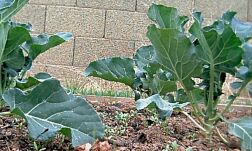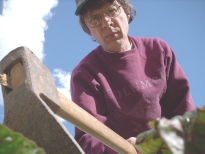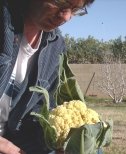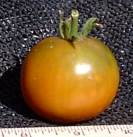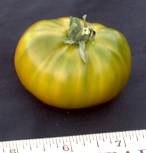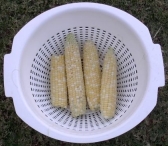Each year, of course, varied in several ways, such as weather, soil preparation, and watering schedules, but this gives some kind of clue about which varieties do well. The taste of the tomato is important to each person. If a tomato doesn't taste good it doesn't do much good to grow more of it. I've forgotten which varieties I preferred. It seems like the mid-sized tomatoes generally tasted better to me.
All of these tomatoes were bought and planted on or after March 15, the stated first guaranteed frost-free date. The tomatoes did real well through May and June. Then in July they started to decline and by August were barely surviving. It took a lot of work, shading and lots of watering, to get them to make it through to the fall when they started to produce again. The fall fruit never seemed to taste as good and wasn't too prolific, so in later years I didn't try to carry the plants through the summer.
In recent years I've never had much success with tomatoes and wonder if the soil hasn't gotten infected with some virus or something.
-----
Then several years later in 2006, I tried several varieties of heirloom tomatoes, types that have been around for years but not planted nearly as often as the modern hybrid types. Here are the estimated results of edible tomatoes. I'd say about half of the tomatoes were lost to insects and sunburn, and the plants weren't given great care, so I believe that with more care it could have been a better harvest.
variety lbs. per plant
------- --------------
Black Prince 2.7
Cherokee Purple 4.8
Debarao 3.3
Druzba 3.8
German Green 3.4
Ozark Pink 2.6
Mountain Gold 1.3
(These estimates are based on a recorded count, but with an estimated weight from memory several months after harvest: Black Prince=3 oz.; German Green=5 oz.; Druzba=5 oz.; Cherokee Purple=12 oz.; Ozark Pink=6 oz.; Mt. Gold=5 oz.; Debarao=4oz.)
-----
Then in 2007, tomatoes were tried again. The main reason was to see what happened with the seeds from the Cherokee Purple tomatoes that were huge and great-tasting. I thought maybe that they weren't really Cherokee Purple as advertised, but that I'd found a new variety that grows large tomatoes in the desert, something that's not supposed to happen. Seven plants were set out: two Cherokee Purple, two Black Prince (my favorite flavor), two Ozark Pink, all grown from seeds; and one Sweet 100 from the store. After several weeks of growing, it appeared that some of them were stunted, with symptoms like curly top virus, so I pulled up the two Cherokee Purples, very reluctantly, and one of the Ozark Pinks that looked puny. It was early enough when I pulled the one Ozark Pink that I put an Early Girl plant from the store in its place. The two Black Prince plants acted poorly shortly after they started bearing tomatoes, so I pulled out one of them too, again reluctantly. The other Black Prince sputtered along and produced a little bit. Here are the totals out of each plant:
variety lbs. per plant planting to 1st tomato
------- -------------- ----------------------
Black Prince 3.5 81 days
Early Girl 3 61 days
Ozark Pink 7 90 days
Sweet 100 7 57 days
These are the totals up through July 10. After that the taste and quality declined, although we used some for cooking. In general, it was a mediocre tomato season. The Ozark Pink tomatoes impressed me, lots of tomatoes that tasted really good when fully ripened, although they bore fruit later than supposed to, if they're indeed Ozark Pink tomatoes (seeds were bought via internet). I don't see that variety touted much for the desert, but would recommend it from my limited experience with it.
-----
Although knowing better, in 2008 that elusive good tomato year was reached for again. Here are the production averages from each plant:
variety lbs. per plant planting to 1st tomato
------- -------------- ----------------------
Black Prince 0.7 90 days
Celebrity 0.8 85 days
Champion 0.1 90 days
Early Girl 0.7 55 days
First Lady II 2.0 60 days
Lemon Boy 0.5 61 days
Southern Star 2.7 95 days
Some tomatoes were picked after the main season but not counted above, mainly the Lemon Boy that kept on eking out several tomatoes. Obviously this wasn't a stellar tomato year -- rather quite dismal. The plants seemed to really drag along before finally producing, and hot summer came suddenly, but not unexpectedly. It seems that none of the tomatoes were vary tasty this year. My favorite flavor is the Black Prince, but even they didn't taste right. The Lemon Boy had a good, zingy flavor. The First Lady was good when very ripe. The Southern Star was okay, an old-fashioned ordinary tomato taste; and it seemed to take the heat well, not bearing for 95 days but then having more production than the other varieties, due in part to its large size.
-----
The main reason for tomatoes in 2009 was that in 2006 one of the Cherokee Purple plants had huge, tasty tomatoes that didn't really look like the typical variety as far as I knew. Some seeds were saved to try to duplicate those strange tomatoes. This was tried in 2007, but the plants didn't make it. The plan fell through again because the tomatoes looked like "normal" Cherokee Purple." It might have been that three years ago there was cross-pollination with another variety, or some other thing going on. Turned out okay anyway since the tomatoes were tasty this season. Here are the production averages from each plant:
variety lbs. per plant planting to 1st tomato
------- -------------- ----------------------
Cherokee Purple 2.0 85 days
Druzba 1.5 85 days
German Green 0.3 101 days
Wish I would have always recorded my subjective taste test so will start this time. The Druzba has a sweet taste, very little tartness and acidic taste. It would be great on a hamburger. The Cherokee Purple is delectable with a strong, rich aftertaste. The German Green is also very good. The last time in 2006 the German Green tomato taste didn't impress me at all, and I almost didn't try it again because of that. Maybe this year picked them more mature -- don't know.
-----
Tried tomatoes again in 2010, and it worked out well making me downright happy. Here are the results:
variety lbs. per plant avg. oz. per tomato planting to 1st tomato
------- -------------- ------------------- ----------------------
Black Krim 7.0 6 3/4 oz. 88 days
Black Prince 10.1 2 1/4 oz. 82 days
Cherokee Purple 3.7 7 1/2 oz. 87 days
Tried Black Krim for the first time after reading that it's a proven variety for the Arizona desert. It definitely produced heavily. The taste isn't to my liking, in fact sometimes okay and sometimes not, but if one wants an occasional one-pound tomato in the desert this is one way of getting there. Of course in all cases it's better than a store-bought tomato. The Black Prince remains a favorite of mine for taste. There were a few cross-pollinated tomatoes thanks to the busy bees that turned out well. The Black Krim & Black Prince mixtures tasted very good. I attribute the good tomato year on a soil amendment, just guessing, an $8 investment of a 40-pound mixture of compost, sphagnum peat, composted manure, and poultry litter. I also mixed in gypsum, and a product that's gypsum pellets with some nitrogen added.
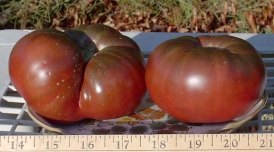 Black Krim tomatoes
Black Krim tomatoes
|
-----
Had to go for tomatoes again in 2011 since last year was a hit. Used the same spot as 2010. Mixed into the soil a product used last season, the gypsum pellets with added nitrogen, called Soil Buster that Lowes was apparently discontinuing and practically giving away awhile back.
lbs. per average oz. days to 1st
variety plant average per tomato tomato
------- ------------- ----------- ---------
Columbia 14 3 1/2 92
Green Zebra 2 2 1/4 93
Marion 12 3 76
Tigerella 3 1 81
Not a bad season at all as far as heavy production. It was my first experience with Marion tomatoes. They did well even though almost all of them had cracked tops, mainly a cosmetic issue. Also my first time for the two heirlooms, Green Zebra and Tigerella. Their appearance was more appealing than their tastes. Tried to come up with a personal taste scale for each variety. Black Prince is still my favorite, so I'll give it a "10" on a 1-to-10 scale. A "1" would go to a tomato that's slightly painful to eat, even though I doubt there is such a commonly-grown tomato that low. Here's how I rank the four this year: Tigerella 7/10, Marion 7/10, Columbia 6/10, Green Zebra 4/10. The Green Zebra had an odd consistency, kind of cottony or something, hard to describe, but I enjoyed each one.
 from left: Marion, Columbia, two Tigerallas, two Green Zebras
from left: Marion, Columbia, two Tigerallas, two Green Zebras
|
-----
Put out one plant for 2013 having limited time for gardening yet wanting some home grown tomatoes. These were tough to chew and had very little flavor of anything, let alone of tomatoes.
